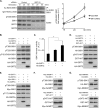Cross-talk between sirtuin and mammalian target of rapamycin complex 1 (mTORC1) signaling in the regulation of S6 kinase 1 (S6K1) phosphorylation
- PMID: 24652283
- PMCID: PMC4036325
- DOI: 10.1074/jbc.M113.520734
Cross-talk between sirtuin and mammalian target of rapamycin complex 1 (mTORC1) signaling in the regulation of S6 kinase 1 (S6K1) phosphorylation
Abstract
p70 ribosomal S6 kinase (S6K1), a major substrate of the mammalian target of rapamycin (mTOR) kinase, regulates diverse cellular processes including protein synthesis, cell growth, and survival. Although it is well known that the activity of S6K1 is tightly coupled to its phosphorylation status, the regulation of S6K1 activity by other post-translational modifications such as acetylation has not been well understood. Here we show that the acetylation of the C-terminal region (CTR) of S6K1 blocks mTORC1-dependent Thr-389 phosphorylation, an essential phosphorylation site for S6K1 activity. The acetylation of the CTR of S6K1 is inhibited by the class III histone deacetylases, SIRT1 and SIRT2. An S6K1 mutant lacking acetylation sites in its CTR shows enhanced Thr-389 phosphorylation and kinase activity, whereas the acetylation-mimetic S6K1 mutant exhibits decreased Thr-389 phosphorylation and kinase activity. Interestingly, relative to the acetylation-mimetic S6K1 mutant, the acetylation-defective mutant displays higher affinity toward Raptor, an essential scaffolding component of mTORC1 that recruits mTORC1 substrates. These observations indicate that sirtuin-mediated regulation of S6K1 acetylation is an additional important regulatory modification that impinges on the mechanisms underlying mTORC1-dependent S6K1 activation.
Keywords: Acetylation; Phosphorylation; Rapamycin; S6 Kinase; Sirt1; Sirtuins; mTOR; mTOR Complex (mTORC).
Figures






Similar articles
-
mTORC1-activated S6K1 phosphorylates Rictor on threonine 1135 and regulates mTORC2 signaling.Mol Cell Biol. 2010 Feb;30(4):908-21. doi: 10.1128/MCB.00601-09. Epub 2009 Dec 7. Mol Cell Biol. 2010. PMID: 19995915 Free PMC article.
-
Activation of mTORC1 is essential for β-adrenergic stimulation of adipose browning.J Clin Invest. 2016 May 2;126(5):1704-16. doi: 10.1172/JCI83532. Epub 2016 Mar 28. J Clin Invest. 2016. PMID: 27018708 Free PMC article.
-
Direct imaging of the recruitment and phosphorylation of S6K1 in the mTORC1 pathway in living cells.Sci Rep. 2019 Mar 4;9(1):3408. doi: 10.1038/s41598-019-39410-z. Sci Rep. 2019. PMID: 30833605 Free PMC article.
-
Role of mTORC1-S6K1 signaling pathway in regulation of hematopoietic stem cell and acute myeloid leukemia.Exp Hematol. 2017 Jun;50:13-21. doi: 10.1016/j.exphem.2017.02.004. Epub 2017 Mar 22. Exp Hematol. 2017. PMID: 28342808 Free PMC article. Review.
-
The complexes of mammalian target of rapamycin.Curr Protein Pept Sci. 2010 Sep;11(6):409-24. doi: 10.2174/138920310791824093. Curr Protein Pept Sci. 2010. PMID: 20491627 Free PMC article. Review.
Cited by
-
Inactivation of Sirtuin2 protects mice from acetaminophen-induced liver injury: possible involvement of ER stress and S6K1 activation.BMB Rep. 2019 Mar;52(3):190-195. doi: 10.5483/BMBRep.2019.52.3.083. BMB Rep. 2019. PMID: 30021675 Free PMC article.
-
Regulation of stem cell aging by SIRT1 - Linking metabolic signaling to epigenetic modifications.Mol Cell Endocrinol. 2017 Nov 5;455:75-82. doi: 10.1016/j.mce.2017.03.031. Epub 2017 Apr 6. Mol Cell Endocrinol. 2017. PMID: 28392411 Free PMC article. Review.
-
Sirt1 and the Mitochondria.Mol Cells. 2016 Feb;39(2):87-95. doi: 10.14348/molcells.2016.2318. Epub 2016 Feb 2. Mol Cells. 2016. PMID: 26831453 Free PMC article. Review.
-
Biochemical Genetic Pathways that Modulate Aging in Multiple Species.Cold Spring Harb Perspect Med. 2015 Nov 2;5(11):a025114. doi: 10.1101/cshperspect.a025114. Cold Spring Harb Perspect Med. 2015. PMID: 26525455 Free PMC article. Review.
-
Longevity and skeletal muscle mass: the role of IGF signalling, the sirtuins, dietary restriction and protein intake.Aging Cell. 2015 Aug;14(4):511-23. doi: 10.1111/acel.12342. Epub 2015 Apr 10. Aging Cell. 2015. PMID: 25866088 Free PMC article. Review.
References
-
- Magnuson B., Ekim B., Fingar D. C. (2012) Regulation and function of ribosomal protein S6 kinase (S6K) within mTOR signalling networks. Biochem. J. 441, 1–21 - PubMed
-
- Saitoh M., ten Dijke P., Miyazono K., Ichijo H. (1998) Cloning and characterization of p70S6Kβ defines a novel family of p70 S6 kinases. Biochem. Biophys. Res. Commun. 253, 470–476 - PubMed
-
- Lee-Fruman K. K., Kuo C. J., Lippincott J., Terada N., Blenis J. (1999) Characterization of S6K2, a novel kinase homologous to S6K1. Oncogene 18, 5108–5114 - PubMed
Publication types
MeSH terms
Substances
Grants and funding
LinkOut - more resources
Full Text Sources
Other Literature Sources
Molecular Biology Databases
Miscellaneous

